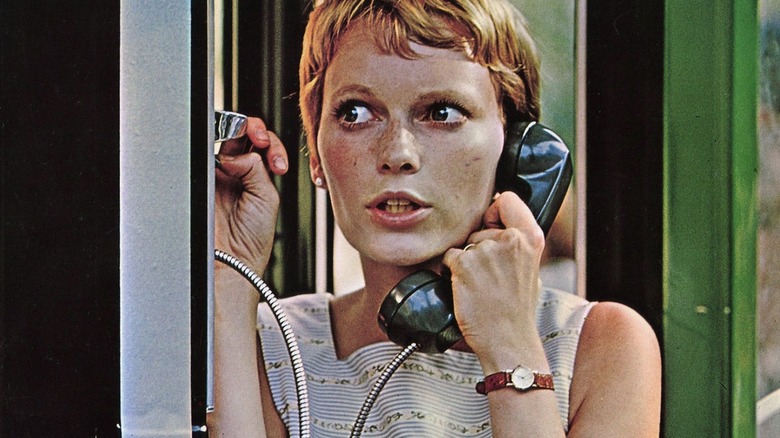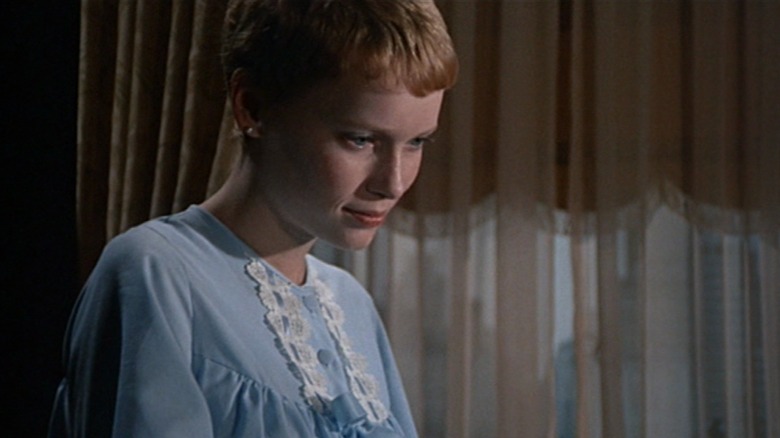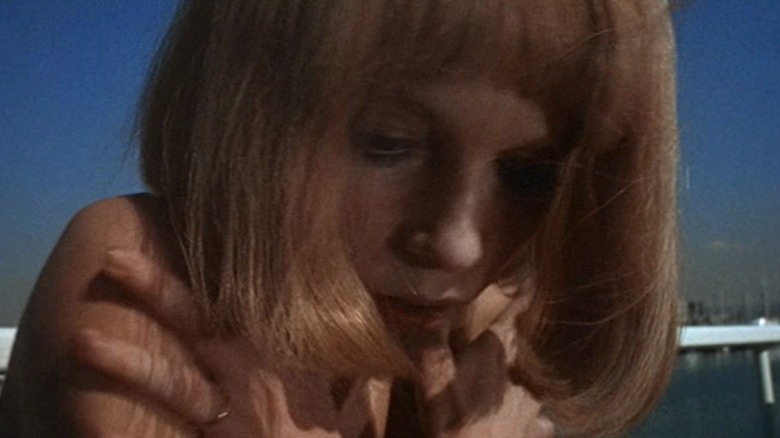Mia Farrow Had An Unexpectedly Pleasant Run-In With The Devil During Rosemary's Baby
In the wake of the #MeToo movement, it's always refreshing to hear about an actress having a non-traumatizing on-set experience filming a sensitive scene — even if that experience comes via the most unlikely of projects. Mia Farrow's time on "Rosemary's Baby" certainly wasn't all sunshine and roses, but in a 2014 Vice interview, the actress and activist described an oddly cordial and borderline silly experience she had shooting one of the film's most horrifying scenes.
In the retrospective, Farrow went into detail about shooting the movie's devilish conception scene, a harrowing horror sequence in which Rosemary is drugged and raped by a demonic presence. Even if we were to set aside the fact that the movie's director, Roman Polanski, remains a fugitive from the law for his own assault and drugging charges (which we shouldn't!), the inciting incident in "Rosemary's Baby" simply looks like it would be a terrifying ordeal to film. Yet Farrow remembers the day with a sense of humor, especially when it came to a devilish co-star who was as polite as could be after filming wrapped.
"This is a funny story," Farrow told Vice. "A guy gets on top of me with — he has vertical contact lenses on and he's, his skin — I mean he's the devil." Farrow said she had a few lines to deliver "while he's grinding away on top of me." The performer in question was "Bonanza" and "Perry Mason" actor Clay Tanner, despite a persistent myth that Church of Satan founder Anton LaVey played the role (a myth started by LaVey himself).
'This is a nice actor man, you know?'
At any rate, after all the simulated movement was done, the actor politely said goodbye to Farrow — while still wearing his full beast costume and makeup. The actress recalled:
"At the end of it all he stands up and he puts out his hand and he said, 'Miss Farrow, it was a pleasure to work with you.' This is a nice actor man, you know? With his vertical lenses and everything. I was like, 'Oh, it's lovely to work with you too.'"
In general, Farrow described the assault scene being filmed in a professional manner. She told Vice she chose not to get naked for the film's nude scenes, so a body double was hired to act in her place in the sequence that involved "being tied to a bed for days on end with no clothes on." She also recalled that actor Sidney Blackmer, who played Rosemary's friendly old neighbor (and secret Satanist) Roman, spoke about trying to remain respectful during a moment in which he had to paint the double's chest. "He said it was a little awkward," Farrow recalled. "He said, 'I just had to see it as if I were painting on a canvas or, you know, the way a butcher carves meat, they don't think of it as an animal.' He had some way of dissociating himself from painting on a girl's chest."
A bundle of contradictions
The assault scene sounds as surreal off-screen as it was in the final product, but a lot less awful. Unfortunately, though, not every experience on set was as professional. For a scene in which Rosemary walks into traffic, Polanski pushed the actress to actually walk into real traffic while he followed her with a handheld camera. In another sequence, in which Rosemary's pregnancy cravings get the better of her, the filmmaker told strict vegetarian Farrow to eat raw liver. "When Roman wanted me to eat raw liver, I ate it, take after take, even though, at the time, I was a committed vegetarian," Farrow wrote in her memoir "What Falls Away."
These uneasy anecdotes are a reminder that "Rosemary's Baby" remains one of the most interesting and dissonant horror movies in history. On the one hand, the film's most violent scene was seemingly handled with care — perhaps more so than was usual at the time, though someone would have to ask Farrow's body double to know for sure. On the other, Farrow has spoken matter-of-factly before about being pushed to do things on set, especially in the traffic scene, during which she said she felt "almost giddy" despite the risk.
These stories are in tune with the movie's own controversial spot in pop culture, where it's remembered as an overtly feminist horror masterpiece despite being made by someone who would eventually be charged with a sex crime. It's clear that the 1960s and '70s were a time of unprecedented creativity in the film industry, but it's also clear that the image of directors as all-powerful creators was too often used as an excuse to put actors, crew members, and others through the wringer. Thankfully, Farrow made it out of "Rosemary's Baby" unscathed — even if she did literally shake hands with the devil.


